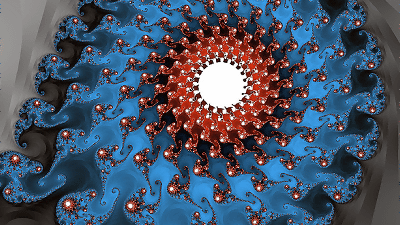The 2020 award-winning work of 'Illusion Video of the Year' that confuses the brain will be announced, and the Japanese will shine in the grand prize

The results of 2020 of 'The Best Illusion of the Year ', which selects the top 10 illusion images that are likely to confuse the brain, have been announced. The grand prize is the ' three-dimensional Schroeder staircase figure ' by Professor Kokichi Sugihara of the Meiji University Research and Intellectual Property Strategy Organization, which is also known as a leading expert in optical illusion research.
2020 Finalists | Best Illusion of the Year Contest
http://illusionSiOyear.com/cat/top-10-finalists/2020/
◆ 1st place: 3D version Schroeder staircase figure
The work of Professor Atsushi Sugiura, who won the grand prize, is a mysterious staircase that 'changes up and down depending on the viewing angle', which is a three-dimensional figure of 'Schroeder staircase figure' known as a classic example of optical illusion. The video is below.
3D Schröder Staircase-YouTube
This is the classic example of the optical illusion, the 'Schroeder staircase figure'.

The Schroeder staircase figure is an optical illusion that it looks like 'a staircase that runs from left to right' and 'the staircase is reversed' at the same time. In the movie, the figure of Schroeder stairs is turned upside down, and it looks like an upside down staircase because the stairs are turned upside down ... No, it looks like the original stairs. You can taste it.


And this is the 'three-dimensional version of Schroeder staircase figure' by Professor Atsushi Sugiura, who said that this is a three-dimensional figure of Schroeder staircase. In the following conditions, it looks like a red cone is placed 'upstairs'.
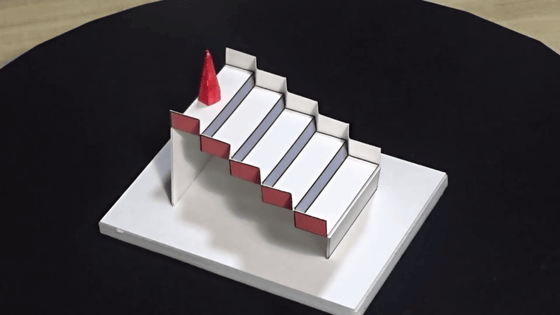
However, if you rotate it 180 degrees, ...
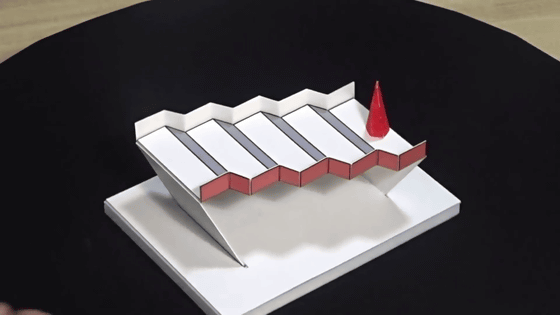
This time it looks like a red cone is placed 'downstairs'.
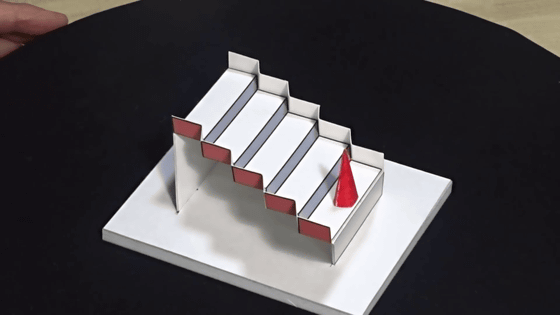
The reason for this mysterious illusion is the shape and pattern of the stairs. At the end of the movie, the story is broken, and the three-dimensional Schroeder staircase figure is not actually a staircase, but a bridge-like shape, and the reason why it looked like a staircase is due to the pattern on the surface. I understand this.
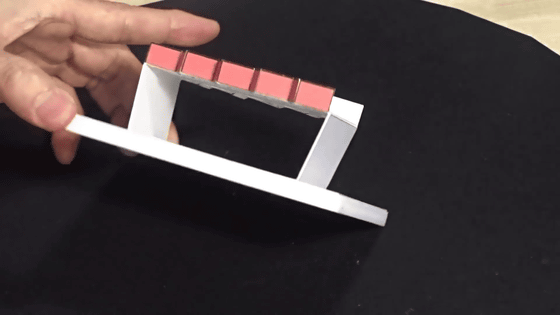
Professor Kokichi Sugihara specializes in mathematical engineering and computer science, and is a person who has published many mathematical studies of graphics such as deception and optical illusions in addition to general graphics mathematics. You can read the explanation of the work of 'Three-dimensional Schroeder staircase figure' by Professor Kokichi Sugihara himself from the following. In addition, a development drawing for paper work (PDF) that allows you to create a 'three-dimensional Schroeder staircase figure' yourself is also posted.
Kokichi Sugihara's Homepage (Japanese)
http://www.isc.meiji.ac.jp/~kokichis/contest/contest2020/contest2020j.html
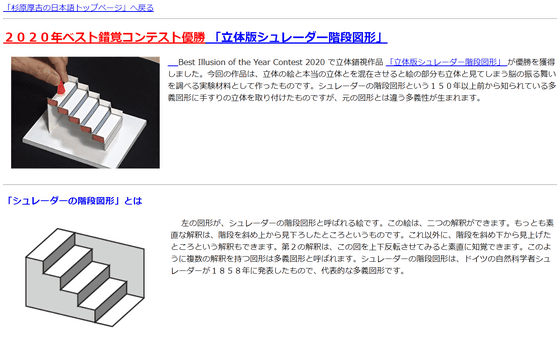
◆ 2nd place: Real? Mirror
The second place was 'The Real Thing' by British science magician Matt Pritchard. The surprising development of the illusion that takes place in front of a single 'mirror' is a must-see.
The Real Thing --YouTube
◆ Third place: Impossible grid-like typography
Dutch graphic designer Daniel Marleveld 's 'Impossible grid typography', which has the theme of moving grid-like 3D characters with uneune, is in 3rd place. If you look closely at the movement of the 3D characters in a grid pattern, you will not be able to tell whether the material of the characters is hard or soft, which direction the characters are rotating, and which is the top or bottom.
Impossible grid typography --YouTube
◆ 4th place: Landing of ladybugs
'Landloping ladybugs: Frame-induced position shift' jointly announced by Mark Wexler, Patrick Kavanagh, and Stuart Antis is fourth. The two ladybugs are only blinking at the same position, but it is an optical illusion that the position of the ladybugs seems to move from side to side as the background framework swings from side to side.
Landloping ladybugs Frame induced position shift --YouTube
◆ 5th place: Illusion of sunlight
'The Sunray Illusion', which is a ring-like figure with multiple layers of polygons, is ranked 5th. The authors are Michael Karlovitch and Pascal Warish of New York University.
The Sunray Illusion-YouTube
The 'light emitted from the center' that you can see when you stare at this figure does not actually exist. Karlovitch et al. 'Because this shape has many intersections and is well aligned, our brain connects the dots to produce a ray. This illusion makes the information presented by our brain plausible. It's an example of the tendency to interpret it as it seems. '
◆ 6th place: X-ray hand
Japanese works are ranked in 6th place again. 'XRAY SCOPE' by Kento Imai and Kenri Kotaka of Kotaka Laboratory , Graduate School of Design, Nagoya City University is a mysterious illusion of showing 'a pen embedded in the hand'. XRAYSCOPE is one of the results of the graduation research of Mr. Imai, a fourth-year student.
XRAYSCOPE-YouTube
In addition, after posting to the contest, it is said that an 'improved version' of XRAY SCOPE was created, and you can see the demo of the improved version on the official Twitter of Kotaka Lab.
As announced at the exhibition the other day, within a few months after posting to this contest, 'XRAYSCOPE' has been transformed into such a system by making full use of media technologies such as UNITY and VIVE TRACKER. However, even if you use the light of a smartphone like you do in the contest video, the essence of the experience does not shake at all. pic.twitter.com/QTD5VM9HnN
— “” Kenrikodaka (@kenrikodaka) December 8, 2020
◆ 7th place: Subtitle super illusion
The 7th place was once again won by the Japanese. 'Subtitles Illusion', a work by Mr. Shinshoji of Gojo High School in Aichi Prefecture, has the theme of 'subtitles' on the video, with fast-moving subtitles on the front side and slow-moving subtitles on the back side. something like. The video itself has no particular meaning.
Subtitles Illusion --YouTube
◆ 8th place: Transparent knife
'Transparent Knife Illusion' created by the brothers of Blaze Barras of North Dakota State University and Benjamin Barras of Benjamin Franklin Middle School. It's as simple as inserting a knife between the forks, but the inserted knife looks as if it's transparent.
Transparent Knife Illusion-YouTube
◆ 9th place: Feeling of tapioca
Mr. Nishiiya, Mr. Onomasaki, and Associate Professor Masashi Nakatani , who belong to Keio University, won the 9th place in the video with the theme of 'tactile sensation'. If you make a hole with a diameter of 1 cm in drawing paper and insert your fingers into the hole from both sides, you will feel 'tapioca'. Use paper-like plastic instead of drawing paper, or change the size of the hole to be made. So, it seems that you can enjoy various feelings.
The Tapioca Tactile Illusion-YouTube
◆ 10th place: Blurred clouds
The 10th place is the illusion that 'blurred clouds' can be seen in the white parts when the parts cut out from the painting are duplicated and arranged. Russell D. Hammer of the Smith Kettlewell Visual Institute at Florida Atlantic University and Christopher W. Tyler at City University of London take advantage of the brain's 'complementary' function of compensating for nonexistent information. It is his work.
Illusory'Misty' Contours-YouTube
The award-winning works of 2019 can be seen in the following articles.
Top 10 illusion videos that are likely to confuse the brain will be announced, 3 works from Japan ranked in --GIGAZINE

Related Posts:
in Video, Posted by darkhorse_log






